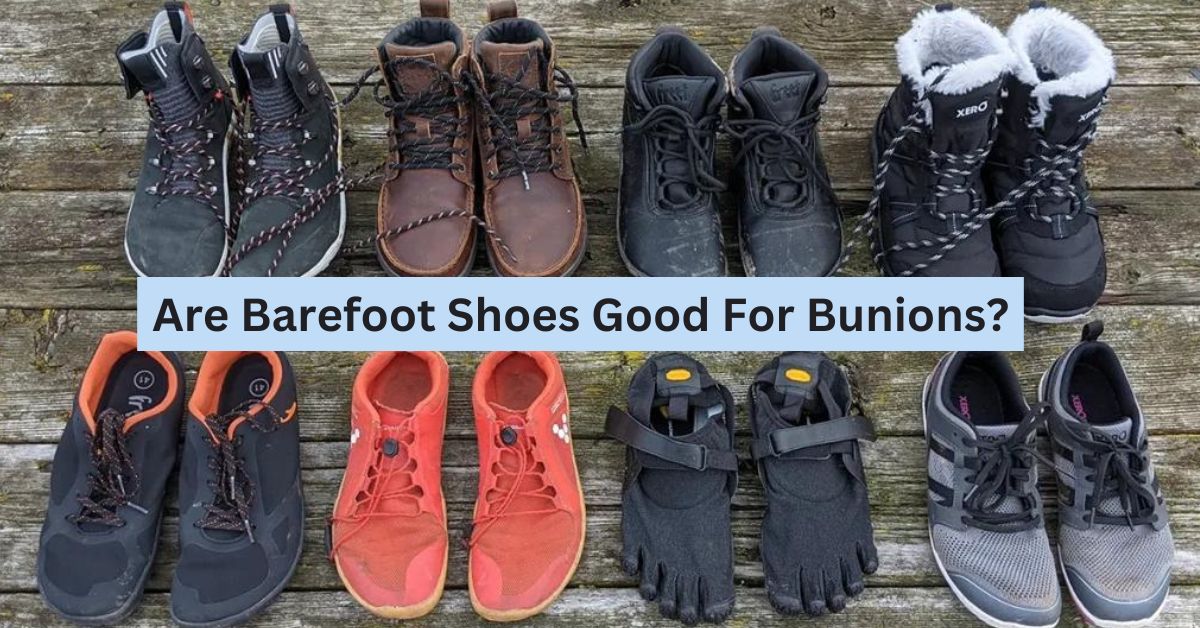Our body functions itself through breathing air in and out. Similarly, our feet need ventilation to perspire the sweat and cool down to maintain internal body temperature. Wearing tight shoes make your feet susceptible to bear extra pressure on its soft tissue structures that may develop bunions. Also, constricted footwear increases sweating that may cause fungal foot infections to occur due to poor hygiene. Having said that, are barefoot shoes good for bunions?
Read more to find out how barefoot shoes cure bunions and what are there health benefits:
What are Barefoot Shoes?
Barefoot shoes are minimalist design shoes made to be really easy and light on the feet. They are breathable and give you the experience of walking barefoot.
Now to answer the question of: are barefoot shoes good for bunions? We will go through some of their specifications here to come to a verdict:
Support
The barefoot shoes provide the feet with an open and breathable toe box. Moreover, the flat heel design takes away the feet extra inches that may cause imbalance and uneven weight distribution. The latter is a primitive feature of heels which answers your question of “Are barefoot shoes good for bunions?”
The barefoot shoes allow your feet to move freely without any external support provided by the shoe which might be the most beneficial alternative in this case.
Toe Alignment
The toe alignment is fixed pretty well with the barefoot design shoes as there is a greater toe box in the front for your toes with bunions to relax properly. This decreases the chances of inflammation and makes them easier to move in.
The flat design also allows you to not put all your feet’s pressure on the toes and worsen the bunion symptoms.
Breathability
The breathability of barefoot shoes’ and ergonomic design allows you to move freely and causes less friction between your toes, making it easier to move around. This prevents the excess sweating in your feet, resulting in reduced chances of big toe inflammation.
Reduced Pressure
The design of barefoot shoes is made in a way that the heels aren’t as pointy as they should be, making the shoe more even in terms of pressure distribution.
When we keep these key points in mind while investing in barefoot shoes, they provide a satisfactory answer to “Are barefoot shoes good for bunions?”
Increase in Mobility
Barefoot shoes offer more comfort and less pressure on your feet that aids you to move with freedom. This lessens the soreness and increases the blood supply to your big toe to provide relief to bunion symptoms.
Comfort
Comfort is a primary goal when investing in any shoes whether you suffer from bunions or not. It is all about the convenience and comfort a shoe has to offer when you’re walking while wearing it. Once you get rid of bunions, barefoot shoes provide enough room for your toes to relax, making them the most reliable option for the daily commute or casual wear.
You need to also make sure what suits your personal comfort better, some people prefer cushioned soles and others prefer flat and breathable ones. It is up to your personal choices as to what shoe to invest in for a smoother walking experience.
You can also check the Best Shoes For Bunions
Who Should Invest in Barefoot Shoes?
Athletes, factory workers, and clinicians are more likely to stand on their feet for the whole day to complete their professional duty. That’s why these individuals are more likely to get bunions. It is easier to take precautions for your feet than to suffer from damage or inflammation due to actual injury or bunion formation.
For that reason, you must consider investing in barefoot shoes to save yourself from the health hazards of bunion development.
Let’s go into the details to find out are barefoot shoes good for bunions or why you should be wearing them?
Who is at a Risk of Developing Bunions?
Here’s the list of people who are at a risk of developing bunions:
- Obese People: People who are overweight are more likely to develop bunions because of the uneven weight distribution on their bones and joints. It makes them more susceptible to get big toe disorders or bunions.
- Athletes: Athletic people are at increased risk to get bunions as they often wear tight shoes with narrow toe-boxes to enhance their foot movement and performance. Shoes with narrow toe-boxes create more pressure on their feet, resulting in bunion formation.
- Business Professionals: People who wear dress shoes on a daily basis have a greater probability of getting bunions. It happens due to the usage of dress shoes which offers less breathability and causes excess sweating, predisposing toenail infections and bunions.
- Women: Women are more likely to suffer from bunions than men because they wear high heels from a very young age that constantly puts pressure on their toes.
- Genetics: Positive family history of bunion formation in the forefathers results in the growth of weaker connective tissues in the offspring that may increase the prevalence of having this big toe condition.
Why Should I Invest In Buying Barefoot Shoes?
It is better to invest in barefoot shoes before developing any serious foot condition. Barefoot shoes are good for people of any age and profession as they provide:
- Barefoot shoes have no elevation or heel to toe drop, which makes them less prone to put pressure on the toes and the pressure of your feet from your body weight is distributed evenly at all parts.
- Their thinner soles allow people to actually experience a feeling similar to that of walking barefooted. This ensures that the feet muscles work up to their full potential and strengthen.
- Flexibility of barefoot shoes is very high compared to normal ones as they have a wider range of motion.
- Podiatrists recommend barefoot shoes to people who are suffering from ankle problems due to their ergonomic design to support foot arches and high breathability.
Types of Barefoot Shoes That You Can Wear and Still Be Stylish
There are different types of barefoot shoes that can be worn by athletes, hikers or normal people to increase their feet’s muscle performance:
- Slip Ons
Slip Ons are a type of lace-less shoes that have flat soles and are easily wearable. They cover a variety of shoes like loafers or slippers.
Slip Ons already has a flat sole that can allow you to easily move around in the thin soles and zero elevation heel platforms.
- Winter Boots
Winter boots are also a form of statement boots that can be worn on a daily basis in winter seasons. Usually, winter boots are not flat-soled; however, some companies do offer barefoot versions of winter boots that could be worn as an alternative.
- Sandals
Sandals are a perfect and breathable option especially if you have bunions or any other inflammation of feet or joints. The natural design of sandals offer a wide toe box to it users to prevent air entrapment and discomfort.
The sole is thin and is usually made of breathable material that stimulates your foot movement in the best way possible.
- Sneakers
Many companies are producing sneakers with flat soles to eliminate excess forces that may work upon medial, lateral, and plantar arches. This helps in providing an effective sneaker-wearing experience to its user besides imposing equal pressure distributions to your feet.
These options definitely tell us the answers to “are barefoot shoes good for bunions”, and also provide stylish options to choose from.
You can also check out Best Tennis Shoes for Bunions
Other Tips to Care for Bunions
Besides wondering “Are barefoot shoes good for bunions” or not, you can invest in different tips and things that can help and relieve your bunions. Here are some of the ideas:
- Using ice compress is very effective for bunions as it reduces inflammation and redness in most cases. After a long day of work, people usually take their feet out of their shoes and put a cold compress on them to reduce their redness.
- Bunion pads are an essential item to have especially if your bunion is affecting your other toes. Bunion pads provide it with isolation, and cushioning to heal on its own.
- Orthotics are foot inserts that can be made according to your feet’s shape making it easier for you to move along in the same pair of shoes but with a supported foot structure.
- Anti-inflammatory medications could be taken for extreme inflammation and painful movement associated with bunion formation to provide short-term relief.
- Physiotherapy could be done to make the joint stronger, reduce its swelling, and aid in strengthening the connective tissue around the area.
- Bunionectomy is a procedure that removes the bunions from your big toe. It is a procedure that involves changing the bone position to fix and straighten the big toe, removing or reducing the bunion from the side of your toe.
The Bottom Line
Bunions are most likely to occur in people who play sports and have to stand for longer hours due to professional requirements. Additionally, obese people and women are at higher risk of developing bunions than other individuals. Wearing barefoot shoes helps you get rid of bunions by equally distributing the body weight throughout your diseased foot. Barefoot shoes also offer greater flexibility, allowing mobility that might be compromised due to bunion development. In conclusion, wearing barefoot shoes are among the effective yet fashionable modifications you can do to cure bunions.
Author Bio
John Locke

Heyy Guys! I’m John from california. I work in a shoe manufacturing factory in California. I have around 15 years of experience in shoe making and shoe inspection especially in orthopedic shoes.

